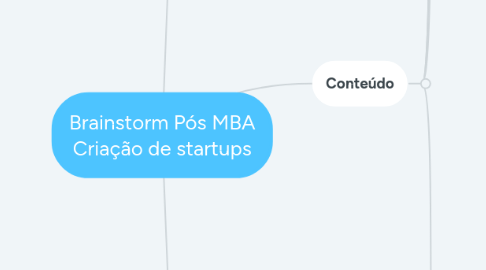
1. Estrutura
1.1. Macromódulos
1.1.1. Módulo
1.1.1.1. # horas
1.1.1.2. Autor
2. Referências
2.1. Books
2.1.1. Value proposition Canvas
2.1.2. Business Model Generation
2.1.3. Talking to Humans
2.2. Articles
2.2.1. Lean Startup - HBR
3. Conteúdo
3.1. Teaching / learning entrepreneurship
3.1.1. Mindset on learning (versus being taught)
3.1.2. Frameworks and best practices: but you gotta get your hands dirty
3.1.3. What you put is what you get
3.1.4. An overview of where all this pedagogy came from...
3.1.5. Business lessons were synonymous with biz plans: why it sucks
3.1.6. Hypothesis + cust dev + agile = Lean Startup
3.1.7. In USA: flipped classroom: here still self-paced
3.1.8. Para quais tipos de idéias & projeto o lean é mais adequado ?
3.1.8.1. Para quais não serve ...
3.1.8.1.1. Não se aplica para projetos com alto nível de pesquisa / incerteza
3.2. Inception
3.2.1. Understanding the Entrepreneurship path
3.2.1.1. So you want to be
3.2.1.1.1. Why ?
3.2.1.2. Career paths
3.2.1.3. Wrong myths: money, fame, no-boss mentality
3.2.1.4. Common wrong reasons: layoffs, work unsatisfaction,
3.2.1.5. Context: risk-reward, family sacrifices, make decisions on the fly, execution, persuasion
3.2.1.6. Start softly: moonlight, run experiments
3.2.1.7. Not everyone needs to be an entrepreneur / CEO
3.2.1.7.1. understand your risk profile
3.2.1.7.2. make a difference (on the company, the customers, the world)
3.2.1.7.3. not a cog: definitely a contributor
3.2.1.8. Flavors of entrepreneurial activity
3.2.1.8.1. Run a business unit
3.2.1.8.2. Intrapreneurship
3.2.1.8.3. International expansion
3.2.1.8.4. Head of product
3.2.1.8.5. Join an early startup TEAM
3.2.1.8.6. Start your own company
3.2.2. Biz plans x lean startup
3.2.3. What is a startup ?
3.2.4. Opportunity recognition
3.2.4.1. Dismiss the idea eureka approach
3.2.4.2. A framework (see original presentation)
3.2.5. Where great ideas - problems ! - come from
3.2.6. Canvas
3.2.6.1. BMC
3.2.6.2. Lean
3.2.6.3. VPC
3.2.6.4. An example - Lean Mama
3.2.7. ICP - ideal customer profile & Customer segments
3.2.7.1. customer x user x payer
3.2.7.2. why they buy ?
3.2.7.3. B2B x B2C
3.2.7.4. multisided market
3.2.7.5. segmentation & archetypes
3.2.8. Problem Interviews & Script
3.2.9. Reach out tactics
3.2.10. Talking to Humans
3.3. Conception
3.3.1. Mockups & Wireframes
3.3.1.1. Prototyping tools
3.3.2. Solution Interview
3.3.3. Smoke tests
3.3.4. MVPs
3.3.4.1. Developing an MVP
3.3.4.1.1. CTO co-founder x sw house approach : pros and cons
3.3.4.1.2. Dating, before you marry
3.3.4.1.3. Start simple: one version, quick iteration
3.3.4.1.4. You do not need to code to know how to judge a good CTO
3.3.5. Produto & Tecnologia
3.3.5.1. UX / UI best practices
3.3.5.2. Tecnologia
3.3.5.2.1. básico pra ter algo minimanente funcional
3.3.6. Team
3.3.6.1. Ideal team profile: hustler, hacker, hipster
3.3.6.2. Find a partner in crime
3.3.6.3. Equity split & formalization
3.3.6.4. Where CTOs hangout
3.3.6.4.1. Tech meetups
3.3.6.4.2. CTOs suggest CTOs
3.3.6.4.3. EngComp & Startup Weekends
3.3.6.4.4. Gama Academy
3.3.6.5. Vesting & long term engagement
3.3.6.5.1. SOP
3.3.6.5.2. How much share to dole out ?
3.3.7. Revenue Model & Pricing
3.3.8. Channels
3.3.9. Running experiments
3.3.10. Traction experiments & Growth
3.3.11. Marketing funnels & Conversion metrics
3.3.11.1. Vanity metrics
3.3.11.2. Key metrics: CAC / LTV / churn
3.3.12. Marketing best practices
3.3.12.1. SEO
3.3.12.2. Social media marketing
3.3.12.3. Content marketing
3.3.13. Financial modelling
3.3.13.1. This is your FUCKING CEO role
3.3.13.1.1. Not the accountants, CFO or anyone else
3.3.13.2. XLS should be a spreadsheet's picture of your real business
3.3.13.2.1. You should master its inner mechanics
3.3.13.3. Revenue projections done right
3.3.13.3.1. Market funnels
3.3.13.3.2. Validated metrics
3.3.13.3.3. Top to bottom line
3.3.13.4. Sales machine
3.3.13.5. Basic cost centers
3.3.13.6. XLS examples
3.3.14. Pivot & business model adjustments
3.4. Growth
3.4.1. Pitch deck
3.4.1.1. Anatomy of an awesome pitch deck (5o Andar)
3.4.1.2. Review of early decks of now famous companies
3.4.2. Investor relationship & attraction
3.4.3. Accelerators: should I join one ?
3.4.4. Opening up a company
3.4.4.1. Contrato social
3.4.4.1.1. conversão do acordo prévio entre sócios
3.4.4.2. Impostos / Simples
3.4.4.3. DRE/Cashflow
3.4.5. Equity x convertible notes
3.4.5.1. risks
3.4.6. Convertible note key topics
3.4.6.1. Interest
3.4.6.2. Discount
3.4.6.3. Cap
3.4.6.4. Governance
3.4.6.5. SOP
3.4.7. Anatomy of a convertible note
3.4.7.1. liq. pref.!
3.4.8. Fundraising
3.4.9. Valuation 101
3.4.9.1. pre x post money
3.4.9.2. underlying rationale for a valuation
3.4.9.3. usual valuations & numbers for early stage businesses
3.4.9.4. why sky high valuations are a bad idea
3.4.9.5. Methods
3.4.10. Equity crowdfunding
3.4.11. Cap table
3.4.11.1. best practices
3.4.11.2. dillution
3.4.12. Company building
3.4.12.1. Team: Management & Structuring teams
3.4.13. Produto e Tecnologia
3.4.13.1. metodologia de desenvolvimento
3.4.13.1.1. agile
3.4.13.1.2. scrum/cambam
3.4.13.2. teste automatizado
3.4.13.3. estruturação de time
3.4.13.3.1. Onboarding
3.4.13.3.2. CX/S
3.4.13.3.3. Suporte
3.4.13.3.4. Vendas / pré-vendas
3.4.13.4. OKRs
3.4.14. TS & Series A
3.4.14.1. Staged financing
3.4.14.2. O que é TS ?
3.4.14.2.1. carta de intenções resmidas
3.4.14.3. Captação
3.4.14.3.1. estar a frente do processo
3.4.14.3.2. dirigir o processo
3.4.14.4. Ter multiplos TS no mesmo timing
3.4.14.5. Due dillig.
3.4.14.6. Closing
3.4.15. Internationalization
3.4.16. Series B to IPO
3.4.17. M&A basics
